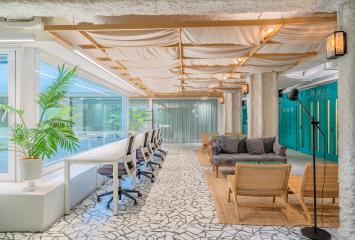Creating Spaces Through Furniture
The modern office is moving inexorably towards more open spaces. New work philosophies—centered around freedom of movement and interaction with colleagues, compared to the rigid setups of early 20th-century offices—are driving architects and designers to prioritize spacious, flexible areas that can be reconfigured according to the specific needs of any given moment.
However, this spontaneous reconfiguration requires movable dividers:
Non-permanent Partition Elements
Partition elements allow for the creation of new spaces. However, traditional options like brick and cement walls come with the complications and costs associated with construction, making them increasingly less desirable. Moreover, and most importantly, they are fixed elements that cannot be easily adjusted. This is in stark contrast to certain pieces of furniture like shelving units or bookcases. In addition to serving as room dividers—thanks to their often considerable height—they offer the opportunity to further customize the office decor.
But they’re not the only option. Other multifunctional pieces, like sofas and armchairs, can both define spaces and create comfortable break areas, providing endless configuration possibilities. Buffets, credenzas, and tables (whether for work or other purposes) can also be strategically used to separate environments. Similarly, while not technically furniture, rugs play a significant role in space delineation, adding warmth, style, and character to different areas.
And of course, there are screens and dividers specifically designed for this purpose. These can be classified into those that provide partial separation and those that offer full separation. It’s advisable to choose mobile screens and partitions made from sustainable materials like bamboo or wood. Ceiling curtains, hanging fabrics, mirrors, floor lamps, and wallpaper or fabric-covered panels can also serve as physical and visual separators, depending on whether the goal is to create fully private work areas or simply to establish a unique ambiance.
Lastly, we should consider the role plants can play in dividing office spaces. Tall potted plants, grouped planters, small horizontal gardens, or vertical gardens can provide the desired level of visual or complete privacy that some companies may seek. Plus, they offer additional biophilic benefits, improve air quality, and contribute to the psychological well-being of employees. The key, however, is to make an eco-friendly selection, prioritizing native and low-maintenance species.

